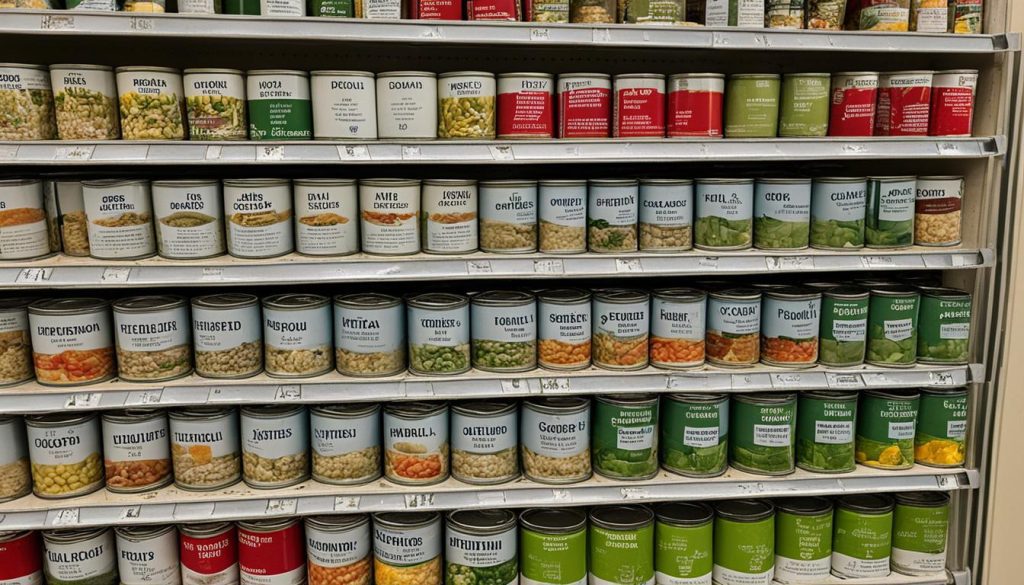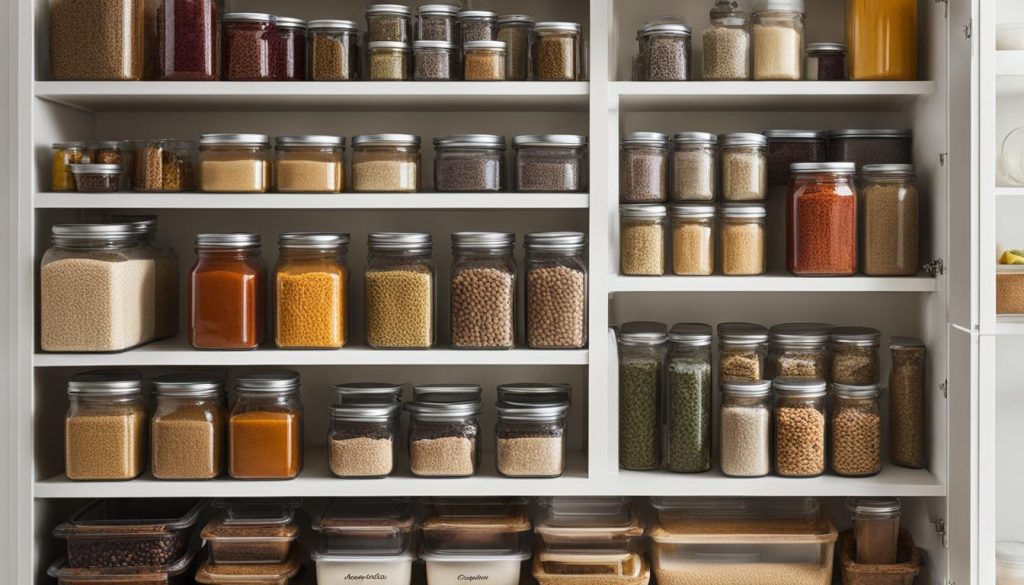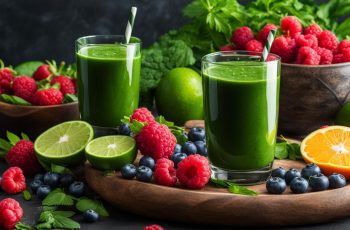Are you tired of throwing away spoiled food and wasting your hard-earned money? Well, I have some good news for you! With these smart food storage hacks, you can save money and make the most of your groceries. By implementing these simple and practical strategies, you’ll be able to extend the shelf life of your food, reduce waste, and keep your budget intact.
Food Storage Hacks to Save Money Unlocked
- Organize your pantry to easily see what you have and avoid buying duplicates.
- Properly store fresh produce to keep it fresh and prevent spoilage.
- Use the FIFO method (First In, First Out) to consume foods before they expire.
- Invest in high-quality storage containers that keep your food fresh and prevent spoilage.
- Freeze smartly by using freezer-friendly packaging and practicing portion control.
Properly Store Fresh Produce
To ensure that your fresh produce stays fresh for as long as possible, it’s important to store it properly. By following these money-saving food storage tips, you can extend the shelf life of your fruits and vegetables and avoid unnecessary waste.
1. Utilize Produce Drawers: Most refrigerators come equipped with produce drawers specifically designed to maintain the right humidity levels for fruits and vegetables. Use these drawers to keep your produce fresh and crisp. Remember to separate ethylene-producing fruits (such as apples and bananas) from ethylene-sensitive ones (such as lettuce and strawberries) to prevent premature ripening.
2. Know the Room Temperature Storage: Not all produce needs to be refrigerated. Certain fruits like avocados, melons, and tomatoes can retain optimal flavor and texture when stored at room temperature. Keep these items in a cool, dry place away from direct sunlight for best results.
3. Practice Good Fridge Practices: When storing perishable liquids, it’s advisable to place them on the inner shelves of the fridge, where the temperature is more consistent. Additionally, wrap fresh herbs in a damp cloth and store them in the fridge to maintain their freshness and extend their usability.
4. Use Airtight Containers: After cutting fruits or vegetables, transfer them into airtight containers to prevent moisture loss. This helps keep the produce crisp and prevents spoilage. You can also place a damp paper towel in the container to maintain humidity levels.
5. Label and Date Leftovers: To prevent food waste, it’s essential to keep track of leftovers. Use labels and date each container to ensure they are consumed within a reasonable timeframe. This practice allows you to plan meals around leftovers and reduces the likelihood of forgetting and wasting them.
Incorporating these proper storage practices will help you make the most of your fresh produce, reduce waste, and save money in the long run. By extending the shelf life of your fruits and vegetables, you can enjoy their full nutritional benefits and minimize the need for frequent grocery shopping.
Use the FIFO Method
One of the most effective food storage hacks to save money and reduce waste is the FIFO (First In, First Out) method. By organizing your pantry and fridge using this method, you can ensure that older items are used before they expire, preventing them from going bad and being wasted.
The key to implementing the FIFO method is to place newer items behind older ones. This way, when you reach into your pantry or fridge for an item, you automatically grab the older ones first. By consuming items before they expire, you can make the most of your groceries and minimize waste.
To effectively use the FIFO method, it’s important to keep track of expiration dates. Regularly check the dates on your food items and use those that are closest to expiration first. By organizing your pantry and fridge and staying mindful of expiration dates, you can reduce food waste and save money on groceries.
Implementing the FIFO method is a simple yet powerful way to make your food storage more efficient and economical. By consuming items in the order they were purchased, you can minimize waste, ensure fresher meals, and ultimately save money.

Invest in Quality Storage Containers
When it comes to maximizing the shelf life of your food and saving money, investing in high-quality storage containers is key. By using the right containers, you can prevent food spoilage and extend the freshness of your groceries.
One essential feature to look for in storage containers is airtightness. Airtight containers create a barrier that prevents moisture loss, keeping your food fresh for longer periods. These containers are specifically designed for food storage and are available in various sizes to cater to your needs.
Consider opting for glass containers for your food storage needs. Not only are they non-absorbent, preventing flavors from leaching into your food, but they also allow you to see what’s inside them without the need to open the containers. Glass containers are also easy to clean, making them a convenient option for everyday use.
By investing in high-quality storage containers, you can minimize food spoilage, reduce waste, and ultimately save money on groceries. These containers provide the perfect environment to extend the shelf life of your food and ensure that it stays fresh until you’re ready to use it.
Having high-quality storage containers in your kitchen is a game-changer for food storage. They help prevent food spoilage, extend the shelf life of your groceries, and save you money in the long run.
Freeze Smartly
Freezing food is an excellent way to extend its shelf life and save money. By utilizing proper freezing techniques, you can avoid food waste and make the most of your grocery budget. Here are some money-saving food storage tips for freezing food smartly:
1. Use Freezer-Friendly Packaging
To prevent freezer burn and protect the quality of your frozen food, opt for freezer-friendly packaging. Airtight containers or freezer bags are ideal for storing food in the freezer. Ensure that the containers or bags are tightly sealed to maintain freshness and prevent any unwanted odors from permeating the food.
2. Practice Portion Control
Divide large quantities of food into smaller portions before freezing them. This allows you to thaw only what you need, preventing unnecessary waste. Proper portion control also helps maintain the quality of the food by avoiding repeated thawing and refreezing.
3. Label Frozen Items
Labeling your frozen items is essential for easy identification and inventory management. Clearly write the contents and the date of freezing on each container or bag. This way, you can keep track of what’s in your freezer and ensure you use items within an appropriate timeframe.
4. Understanding “Best Before” vs. “Use By” Dates
Knowing the difference between “Best Before” and “Use By” dates is crucial for making informed decisions about the freshness and safety of your frozen food. “Best Before” dates indicate the optimal quality of the product, while “Use By” dates indicate when the food is no longer safe to consume. It’s important to follow these guidelines to avoid any potential foodborne illnesses.
By following these food storage hacks to save money and freezing food smartly, you can maximize the shelf life of your groceries and minimize waste. Incorporate these tips into your freezer storage routine to save money on your grocery bills and enjoy fresh, delicious meals whenever you need them.
Store Condiments Properly
Properly storing condiments is a crucial step in reducing food waste and saving money. Many off-the-shelf condiments have long shelf lives, but it’s important to pay attention to the expiration dates and store them correctly. By following these food storage hacks, you can preserve the freshness of your condiments and avoid unnecessary waste.
One simple tip is to mark the purchase and opening dates on the bottles or jars. This way, you can keep track of how long the condiments have been stored and ensure that you use them within the recommended time frame. By staying mindful of expiration dates, you can avoid using expired condiments and prevent any negative effects on the taste or quality of your dishes.
Understanding the proper storage guidelines for each condiment is also essential. Some condiments, like ketchup and mustard, can be stored in the pantry at room temperature. However, others, like mayonnaise and salsa, need to be refrigerated. Always check the label or manufacturer’s instructions for specific storage guidelines to maintain the flavor and quality of your condiments.
Keep in mind that properly storing condiments doesn’t just help you save money, but it also ensures the safety of your food. Old or improperly stored condiments can become a breeding ground for bacteria, posing health risks. By implementing these storage practices, you can minimize waste, save money, and keep your condiments fresher for longer.
If you need further assistance with food storage, refer to the comprehensive guide provided by the Food and Drug Administration (FDA). They offer valuable information on safe food storage practices to help you reduce food waste and promote food safety.
Organize Your Pantry and Cabinets
Organizing your pantry and cabinets is a great way to save money and prevent food waste. By implementing a few simple strategies, you can maximize the use of your storage space and keep track of your food inventory. Here are some money-saving food storage tips to help you organize your pantry and cabinets:
Arrange Items by Expiration Date
One effective way to prevent food waste is to arrange items in your pantry and cabinets by expiration date. By keeping older items towards the front and newer items towards the back, you can ensure that older products are used first. This practice helps to prevent items from expiring without being consumed.
Separate Produce
When storing fruits and vegetables, it’s important to separate certain items to prevent spoilage. Some fruits, like apples and bananas, release ethylene gas, which can cause nearby produce to ripen and spoil faster. By storing these ethylene-producing fruits separately from ethylene-sensitive produce, you can extend the shelf life of your fruits and vegetables.
Consider Specialized Storage Needs
Different kitchen goods have specialized storage needs to maintain their freshness and extend their shelf life. For example, storing spices in a cool, dark place can help preserve their flavor. Nuts and oils should be stored in airtight containers to prevent them from going rancid. Understanding the specific storage requirements for each item can help you optimize their longevity.
Utilize Storage Containers and Labels
Using storage containers and labels can help you keep your pantry and cabinets organized. Invest in airtight containers to keep items fresh and to prevent pests from getting into your food. Labeling containers and shelves can help you quickly identify where items are stored and when they were opened or purchased, making it easier to use items within their recommended timeframes.
By implementing these organization tips, you can save money by reducing food waste and making the most of your pantry and cabinets. Organized storage not only helps you keep track of what you have but also ensures that you use items before they expire. So go ahead and give your pantry and cabinets a makeover to create an efficient and waste-free food storage system!

Conclusion
By implementing these smart food storage hacks, you can reduce food waste, maximize your grocery budget, and save money. Properly storing fresh produce, using the FIFO method, investing in quality storage containers, freezing smartly, and organizing your pantry and cabinets are all effective strategies for extending the shelf life of your food and minimizing waste.
When it comes to storing fresh produce, ensure that you store them properly to maintain their freshness for as long as possible. This includes using produce drawers in your refrigerator, storing certain fruits and vegetables at room temperature, and practicing good fridge habits.
Using the FIFO method in your pantry and fridge helps you consume items before they expire, reducing food waste. Keep track of expiration dates and organize your products accordingly, making sure you use the oldest items first.
Investing in high-quality storage containers, such as airtight containers or glass containers, prolongs the shelf life of your groceries. These containers prevent moisture loss and spoilage, keeping your food fresh and saving you money in the long run.
Freezing food smartly is a great way to extend its shelf life. Use freezer-friendly packaging, portion control, and label frozen items to keep track of what you have. Understanding the difference between “Best Before” and “Use By” dates helps you make informed decisions about the safety and freshness of frozen food.
Lastly, organizing your pantry and cabinets is crucial to prevent food waste. Arrange items by expiration date, separate produce with different storage needs, and consider specialized storage for certain kitchen goods. By implementing these tips, you can make the most of your pantry and cabinets, minimizing waste and maximizing your grocery budget.
Start implementing these smart food storage methods today and enjoy fresh and delicious meals while staying budget-friendly.
FAQ
What are some food storage hacks to save money?
Some food storage hacks to save money include properly storing fresh produce, using the FIFO method, investing in quality storage containers, freezing smartly, and organizing your pantry and cabinets.
How can I properly store fresh produce to make it last longer?
To properly store fresh produce, use produce drawers in your refrigerator, store fruits and vegetables at the right temperature, wrap herbs in damp cloths, use airtight containers for cut produce, and label and date leftovers.
What is the FIFO method and how does it help save money?
The FIFO method stands for First In, First Out. It involves organizing your pantry and fridge so that older items are used before newer ones. This method helps prevent food waste and ensures that items are consumed before they expire.
Are high-quality storage containers worth the investment?
Yes, investing in high-quality storage containers is worth it. Look for airtight containers designed for food storage, such as glass containers. These containers prevent moisture loss and keep your food fresh for longer, ultimately saving you money by reducing food spoilage.
How can I freeze food effectively to extend its shelf life?
To freeze food effectively, use freezer-friendly packaging, such as airtight containers or freezer bags, practice portion control, label frozen items, and understand the difference between “Best Before” and “Use By” dates. Freezing food smartly helps prevent waste and saves money.
How do I store condiments properly to prevent spoilage?
To store condiments properly, pay attention to expiration dates, mark purchase and opening dates, and follow the storage guidelines for each condiment. Properly storing condiments helps prevent spoilage and extends their shelf life, saving you money.
How can I organize my pantry and cabinets to minimize food waste?
To organize your pantry and cabinets, arrange items by expiration date, separate certain produce to prevent spoilage, and consider specialized storage needs for kitchen goods. By organizing your storage spaces, you can reduce food waste and make the most of your groceries.
What are the benefits of implementing these food storage hacks?
Implementing these food storage hacks can help reduce food waste, maximize your grocery budget, and save money. Properly storing food, using the FIFO method, investing in quality containers, freezing smartly, and organizing your pantry all contribute to minimizing waste and saving money on your food expenses.




